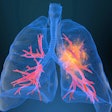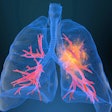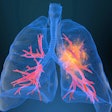
University of Louisville researchers are developing a noninvasive early lung cancer detection method that combines statistical and machine-learning techniques to analyze breath samples that consist of carbonyl volatile organic compounds (VOCs).
In a study published this week in PLOS One, they proposed an experimental approach for the generation of VOC molecular concentration data using silicon microreactor technology.
If it can be developed, validated, and commercialized, a test that uses VOCs for detection would have numerous advantages over current methods. Although some breath tests have been developed to detect COVID-19, none have been successfully developed to detect cancers.
Lung cancer screening methods include chest radiography, sputum cytology, and fluorescence bronchoscopy, but not only are these methods time-consuming, they are also complex and expensive, putting them out of reach for low-income patient groups, the researchers wrote.
"Earlier studies showed that there are several thousand(s) of VOCs in human breath,” the team wrote. “The combinations of some VOCs reported in the literature can comfortably discriminate the lung cancer patients from the healthy ones.”
Not every VOC can be monitored, nor are they all necessary for early diagnosis, the team said. The researchers chose to narrow the list of significant VOCs relevant to lung cancer detection to save time and lower the cost of data generation for all VOCs.
The team took breath samples of 414 subjects. Among the participants, 156 had lung cancer, 65 had benign pulmonary nodules, and 193 were part of a healthy control group consisting of patient family members who did not have lung cancer or other pulmonary conditions. Most lung cancer patients were either current or former smokers, while the “healthy controls included 113 current or former smokers and 80 never smokers,” the team wrote.
Participants were instructed to exhale through a Teflon tube into Tedlar bags to provide one liter of exhaled breath sample for analysis. The bags were connected to silicon microreactors to gather VOC concentration data.
The researchers found 27 relevant VOCs and then used a statistical method called bootstrap support vector machine-recursive feature elimination (Boot-SVM-RFE) to narrow the list down to a few significant VOCs.
Through this method, the study “found that instead of using all the VOCs, one can focus on a few [for example, three, five, or seven] marker VOCs to detect lung cancer patients more robustly and accurately,” the team wrote.
The team identified seven key VOCs: C4H8O2, C13H22O, C11H22O, C2H4O2, C7H14O, C6H12O, and C5H8O. These proved sufficient to distinguish the lung cancer patients, with higher mean classification accuracy (92%) and lower standard of error (0.03) compared to the other combinations.
“This approach will be less time-consuming and require [fewer] resources to detect lung cancer based on exhaled breath samples,” the researchers wrote.
The approach holds several advantages over previous screening methods, the team added. Their technique uses silicon microreactors with thousands of micropillars, enabling high capture rates of carbonyl compounds from each exhaled breath sample. Additionally, “chemo-selective capture of carbonyl compounds through amino-oxy reactions simplifies the spectrum of compounds to be quantitated,” the authors wrote.
They suggest that the analytical methods used could be applied to RNA-sequencing and single-cell RNA-sequencing studies for the identification of cancer patients or cell types, writing, “[t]he reported experimental approach can be applied to other urine, saliva, and blood bioassay-based genetic studies to predict the phenotypes by identifying the organic compound-based biosignatures ... Further, our experimental and analytical approach of VOC quantitative analysis in breath samples may be extended to other diseases, including COVID-19 detection.”



















